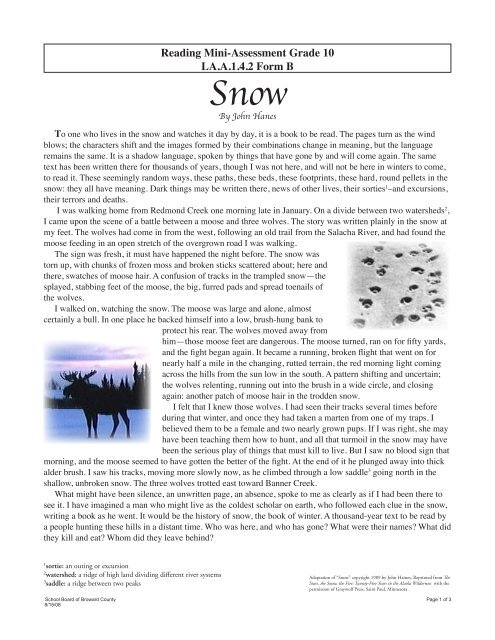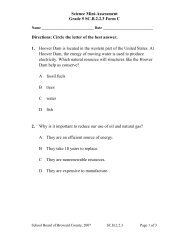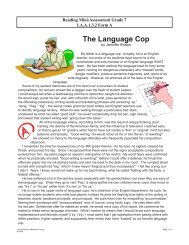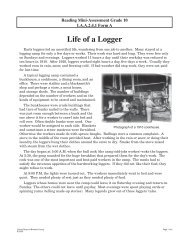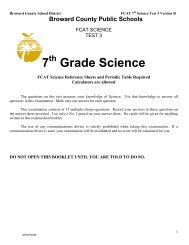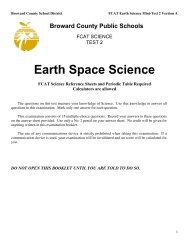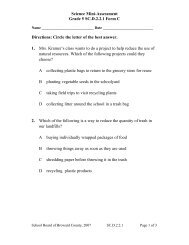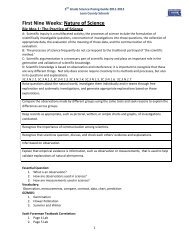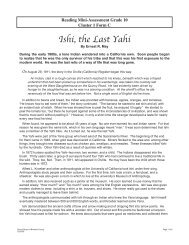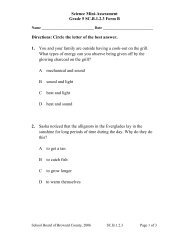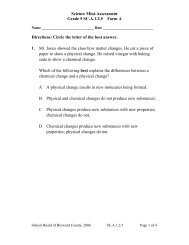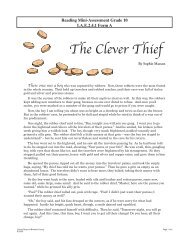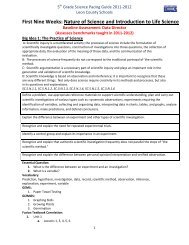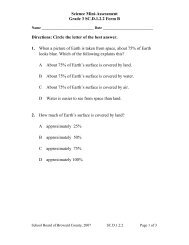Reading Mini-Assessment Grade 10 LA.A.1.4.2 Form B
Reading Mini-Assessment Grade 10 LA.A.1.4.2 Form B
Reading Mini-Assessment Grade 10 LA.A.1.4.2 Form B
You also want an ePaper? Increase the reach of your titles
YUMPU automatically turns print PDFs into web optimized ePapers that Google loves.
<strong>Reading</strong> <strong>Mini</strong>-<strong>Assessment</strong> <strong>Grade</strong> <strong>10</strong><br />
<strong>LA</strong>.<strong>A.1.4.2</strong> <strong>Form</strong> B<br />
Snow<br />
By John Hanes<br />
To one who lives in the snow and watches it day by day, it is a book to be read. The pages turn as the wind<br />
blows; the characters shift and the images formed by their combinations change in meaning, but the language<br />
remains the same. It is a shadow language, spoken by things that have gone by and will come again. The same<br />
text has been written there for thousands of years, though I was not here, and will not be here in winters to come,<br />
to read it. These seemingly random ways, these paths, these beds, these footprints, these hard, round pellets in the<br />
snow: they all have meaning. Dark things may be written there, news of other lives, their sorties 1 –and excursions,<br />
their terrors and deaths.<br />
I was walking home from Redmond Creek one morning late in January. On a divide between two watersheds 2 ,<br />
I came upon the scene of a battle between a moose and three wolves. The story was written plainly in the snow at<br />
my feet. The wolves had come in from the west, following an old trail from the Salacha River, and had found the<br />
moose feeding in an open stretch of the overgrown road I was walking.<br />
The sign was fresh, it must have happened the night before. The snow was<br />
torn up, with chunks of frozen moss and broken sticks scattered about; here and<br />
there, swatches of moose hair. A confusion of tracks in the trampled snow—the<br />
splayed, stabbing feet of the moose, the big, furred pads and spread toenails of<br />
the wolves.<br />
I walked on, watching the snow. The moose was large and alone, almost<br />
certainly a bull. In one place he backed himself into a low, brush-hung bank to<br />
protect his rear. The wolves moved away from<br />
him—those moose feet are dangerous. The moose turned, ran on for fifty yards,<br />
and the fight began again. It became a running, broken flight that went on for<br />
nearly half a mile in the changing, rutted terrain, the red morning light coming<br />
across the hills from the sun low in the south. A pattern shifting and uncertain;<br />
the wolves relenting, running out into the brush in a wide circle, and closing<br />
again: another patch of moose hair in the trodden snow.<br />
I felt that I knew those wolves. I had seen their tracks several times before<br />
during that winter, and once they had taken a marten from one of my traps. I<br />
believed them to be a female and two nearly grown pups. If I was right, she may<br />
have been teaching them how to hunt, and all that turmoil in the snow may have<br />
been the serious play of things that must kill to live. But I saw no blood sign that<br />
morning, and the moose seemed to have gotten the better of the fight. At the end of it he plunged away into thick<br />
alder brush. I saw his tracks, moving more slowly now, as he climbed through a low saddle 3 going north in the<br />
shallow, unbroken snow. The three wolves trotted east toward Banner Creek.<br />
What might have been silence, an unwritten page, an absence, spoke to me as clearly as if I had been there to<br />
see it. I have imagined a man who might live as the coldest scholar on earth, who followed each clue in the snow,<br />
writing a book as he went. It would be the history of snow, the book of winter. A thousand-year text to be read by<br />
a people hunting these hills in a distant time. Who was here, and who has gone? What were their names? What did<br />
they kill and eat? Whom did they leave behind?<br />
1<br />
sortie: an outing or excursion<br />
2<br />
watershed: a ridge of high land dividing different river systems<br />
3<br />
saddle: a ridge between two peaks<br />
Adaptation of “Snow” copyright 1989 by John Haines. Reprinted from The<br />
Stars, the Snow, the Fire: Twenty-Five Years in the Alaska Wilderness with the<br />
permission of Graywolf Press, Saint Paul, Minnesota .<br />
School Board of Broward County Page 1 of 3<br />
8/15/08
<strong>Reading</strong> <strong>Mini</strong>-<strong>Assessment</strong> <strong>Grade</strong> <strong>10</strong><br />
<strong>LA</strong>.<strong>A.1.4.2</strong> <strong>Form</strong> B<br />
Name __________________________________________ Date ___________________<br />
Directions: Read the passage “Snow,” then select the correct answer.<br />
1. Read this sentence from the passage.<br />
If I was right, she may have been teaching them how to hunt, and all that turmoil in the snow<br />
may have been the serious play of things that must kill to live.<br />
What does the phrase serious play of things that must kill to live mean?<br />
A. Young animals in the wild must be aware of dangers when they play in the snow.<br />
B. Young animals in the wild are practicing survival skills when they appear to be playing.<br />
C. Young animals in the wild can be accidentally killed if they play too roughly.<br />
D. Young animals in the wild are taught to act like they are playing as they hunt for food.<br />
2. Read this sentence from the passage.<br />
A confusion of tracks in the trampled snow—the splayed, stabbing feet of the moose, the big,<br />
furred pads and spread toenails of the wolves.<br />
What does the author mean by “a confusion of tracks in the trampled snow”?<br />
A. There are moose and wolf tracks going in all directions.<br />
B. The wolves became confused and distracted by all the moose tracks.<br />
C. All the moose and wolf tracks in the snow puzzle the author.<br />
D. The moose and wolves try to confuse each other by making different tracks in the snow.<br />
3. Which word best describes the observer’s reaction to the scene of a battle between a moose and wolves?<br />
A. distressed<br />
B. sympathetic<br />
C. judgmental<br />
D. contemplative<br />
4. What does the author mean by this sentence from the essay?<br />
These seemingly random ways, these paths, these beds, these footprints, these hard, round<br />
pellets in the snow: they all have meaning.<br />
A. Signs in the snow lead to different interpretations of the truth.<br />
B. Signs in the snow lead to different directions in the wilderness.<br />
C. Signs in the snow can be connected to form a story of nature.<br />
D. Signs in the snow can be connected to lead the observer to safety.<br />
School Board of Broward County Page 2 of 3<br />
8/15/08
<strong>Reading</strong> <strong>Mini</strong>-<strong>Assessment</strong> <strong>Grade</strong> <strong>10</strong><br />
<strong>LA</strong>.<strong>A.1.4.2</strong> <strong>Form</strong> B<br />
ANSWER KEY – Snow<br />
<strong>LA</strong>.<strong>A.1.4.2</strong>: meanings of words phrases and sentences using context clues and word structure<br />
1. Read this sentence from the passage.<br />
If I was right, she may have been teaching them how to hunt, and all that turmoil in the snow<br />
may have been the serious play of things that must kill to live.<br />
What does the phrase serious play of things that must kill to live mean?<br />
A. Young animals in the wild must be aware of dangers when they play in the snow.<br />
B. Young animals in the wild are practicing survival skills when they appear to be playing.<br />
C. Young animals in the wild can be accidentally killed if they play too roughly.<br />
D. Young animals in the wild are taught to act like they are playing as they hunt for food.<br />
2. Read this sentence from the passage.<br />
A confusion of tracks in the trampled snow—the splayed, stabbing feet of the moose, the big,<br />
furred pads and spread toenails of the wolves.<br />
What does the author mean by “a confusion of tracks in the trampled snow”?<br />
A. There are moose and wolf tracks going in all directions.<br />
B. The wolves became confused and distracted by all the moose tracks.<br />
C. All the moose and wolf tracks in the snow puzzle the author.<br />
D. The moose and wolves try to confuse each other by making different tracks in the snow.<br />
3. Which word best describes the observer’s reaction to the scene of a<br />
battle between a moose and wolves?<br />
A. distressed<br />
B. sympathetic<br />
C. judgmental<br />
D. contemplative<br />
4. What does the author mean by this sentence from the essay?<br />
These seemingly random ways, these paths, these beds, these footprints, these hard, round<br />
pellets in the snow: they all have meaning.<br />
A. Signs in the snow lead to different interpretations of the truth.<br />
B. Signs in the snow lead to different directions in the wilderness.<br />
C. Signs in the snow can be connected to form a story of nature.<br />
D. Signs in the snow can be connected to lead the observer to safety.<br />
Item #<br />
Answer<br />
1. B<br />
2. A<br />
3. D<br />
4. C<br />
School Board of Broward County Page 3 of 3<br />
8/15/08


